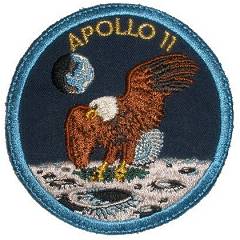Embroidered Patch Terminology
Below I try to briefly explain some of the technical terms commonly used when discussing the details of embroidered patches. Most of this is probably familiar to experienced patch collectors but it's still worth clearly defining the meaning of these terms in the context of embroidered patches.
Fully Embroidered vs Partially Embroidered
A fully embroidered patch is one where no base cloth is left exposed. Fill stitching is used to cover all areas of the design with thread. Due to the quantity of thread used a fully embroidered patch will generally cost more to produce than a partially embroidered equivalent.
A partially embroidered patch is one where some areas of the base cloth (usually twill but sometimes felt or velveteen) are left exposed as part of the design. In general the exposed areas usually form the background or outer border of the artwork.
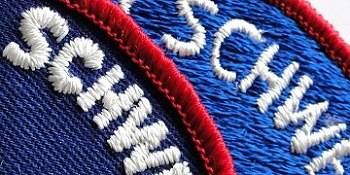 A partially embroidered patch (left) and fully embroidered patch (right)
A partially embroidered patch (left) and fully embroidered patch (right)
There are a number of reasons why a patch may be executed as partially embroidered:
- Cost: The more thread used in a design the higher the unit cost, thus partially embroidered patches are generally cheaper to manufacture.
- Contrast: In some cases the foreground of an embroidered design may stand out better against a plain cloth background than against a surround of fill thread.
- Detail: The fine details in some patch designs may be more clearly visible when stitched over an exposed cloth background rather than over fill thread.
- Additional color: Most embroidered patches have the design executed in at most eight different color threads. In a partially embroidered design the exposed cloth backing provides an additional color, expanding the available palette to nine colors.
Some people consider fully embroidered patches to be more attractive than partially embroidered versions but this is largely a question of personal taste. Certain designs may look better executed fully embroidered and others partially embroidered.
One notable disadvantage of partially embroidered patches, at least in vintage examples without pastic coatings on the back, is that they are highly susceptible to glue staining.
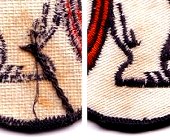
Patches bought in the 60s were frequently mounted to album pages or to framed displays using glue on the reverse, and in some cases the loose tail at the back of a patch was also glued across the back of a patch,as is the case with the Snoopy patch shown on the right.
As glues age they sometimes become discolored, turning yellow or orange over time. On fully embroidered patches any staining on the reverse of the patch is unlikely to affect the front but with partially embroidered patches the staining may well become visible on the exposed areas of backing cloth on the front of the patch.
Border types - Merrowed Edge / Stitched Border / Cut Edge
The simplest edge type for an embroidered patch is the cut edge, sometimes referred to as a trimmed, Schiffli or flat edge.
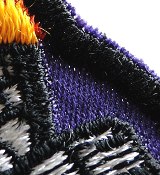
The outer border of the design is stitched and the excess base cloth cut away around the outside of the border by hand or machine. This always leaves some exposed base cloth at the extreme edge of the patch outside the stitched border, as can be seen with the tufts of purple twill on the edge of the Lion Brothers Apollo 7 patch variant shown on the right.
This was actually the most common type of border before the merrowed edge was introduced in the 1960s, but continued to be used thereafter for designs of unusual shape where some elements of the patch extend past the central body area (for example the NASA meatball patch), creating sharp points where a merrowed border cannot be applied.
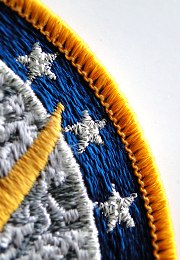
The most common type of border seen on embroidered patches is the over-edge stitch or merrowed edge, as shown on the right. This was generally applied by machinery supplied by Merrow Machines, hence the common name.
After the patch is embroidered and cut the edge is covered by overlocked stitches that run from the front to the back of the patch passing over the edge.
The first NASA mission patch to use a merrowed edge appears to be Gemini 8 in 1966, although the crew patches for Gemini 9, 10, 11 and 12 which followed all had cut edges.
Most of the Apollo mission patches, starting with that of Apollo 1 in 1967, had merrowed edges.
Tails & Selvedged patches
When talking about embroidered patches the term tail (or pigtail) is commonly-used to refer to the excess material which is found where the border of the patch overlaps itself.
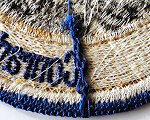
The tail cannot be trimmed away as this could lead to the loose ends unravelling so instead on vintage patches (prior to the introduction of plastic coatings) the tail was usually glued across the back of the patch, as seen on AB Emblem Apollo-era space patches for example.
A more elegant finish is produced by pulling the loose tail through the border thread where it overlaps and sewing it in place with an overedge stitch, producing a finish known as selvedged.
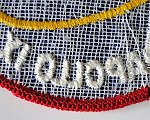
This process was time consuming as it had to be done by hand but was used by several companies that produced space patches during the Gemini and Apollo era, including Texas Art Embroidery, Voyager Emblems and Lion Brothers.
Error patches
An error patch is one that has a noticeable flaw resulting from a mistake during the manufacturing process. These error patches are occasionally mistaken by collectors for previously unseen rare variants.
Error patches that were spotted during the manufacturing process became factory rejects. These would generally have been destroyed but it was also quite common for employees to be able to take home rejected patches to give to their children.
Those error patches that slipped by the quality inspection process at the factory would obviously go on to be sold and, along with the factory rejects that were originally given by factory workers to their families, these error patches often find their way back to the market today. In most cases the seller is unlikely to realize that there is anything wrong with the patch.
Below I discuss some of the most commonly-seen errors in detail.
Thread color switches
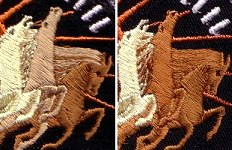
This is where one or more spools of thread were wrongly loaded into the embroidery machine producing a patch with a different color scheme to the standard one.
Shown above is detail of the regular AB Emblem Apollo 13 patch (left) alongside an error patch (right) where the light brown thread used for the body of the center horse and for part of the mane of the right hand horse has been replaced by the brown color used for the right hand horse.
Missing elements
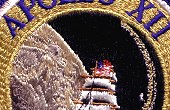
Problems with the machinery during the embroidery process (e.g. where the needle jams or runs out of thread part way through the process) will commonly leave parts of the design missing.
This is most obvious with missing parts of text but less easy to spot when it's a background element, as in the three missing stars in the Apollo 12 example shown above.
Incomplete borders
Patches that have not had the final outer merrowed border applied appear quite frequently for sale.
In some cases this can be quite striking, particularly if the border is usually made up of overlain elements.
A typical example is the Lion Brothers Apollo 11 patch shown on the right, which is frequently mistaken for a rare blue bordered variant when in fact it is simply an error patch.
The closeup photo below shows the border of a damaged Apollo 11 Lion Brothers patch.
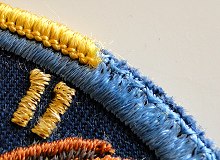
Here you can clearly see that the patch was manufactured with a broad stitched blue border and cut edge, over which a narrower merrowed border in yellow thread was then applied to produce a two colored border.
When this merrowed edge has not been applied, leaving the blue stitched border exposed all the way round, the result is a patch like the one shown above which people so often mistake for a rare blue bordered variant.
The Apollo 11 Lion Brothers patch is just one example. The same principal applies to all of the patches manufactured with a merrowed edge. An example with a missing outer border can look suprisingly different from the regular version but should not be mistaken for a variant.
In general error patches have no real value for patch collectors. Indeed they are generally worth little or nothing unless they are examples of extremely rare patches in which case they may have some residual value as stand-ins for a perfect example of the patch. Unlike error stamps or currency there is no particular interest in embroidered patches with manufacturing flaws.
